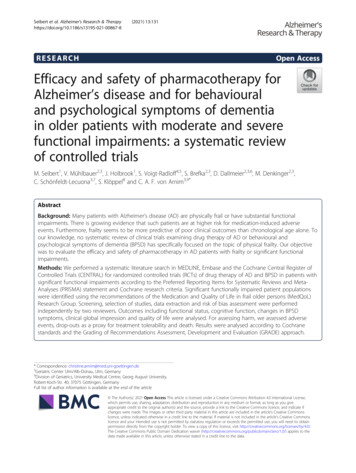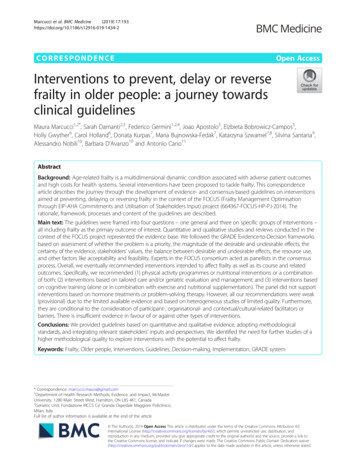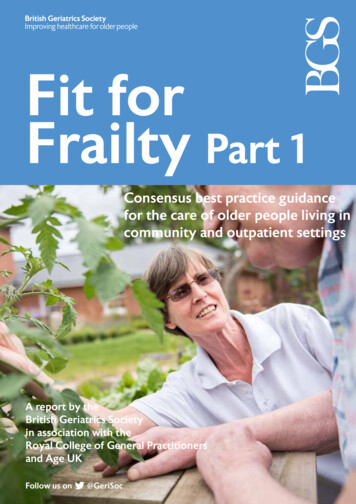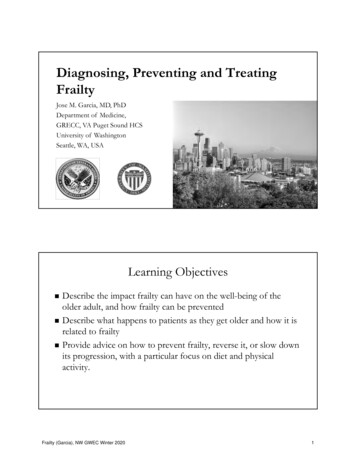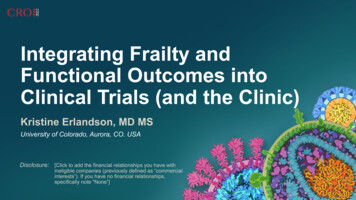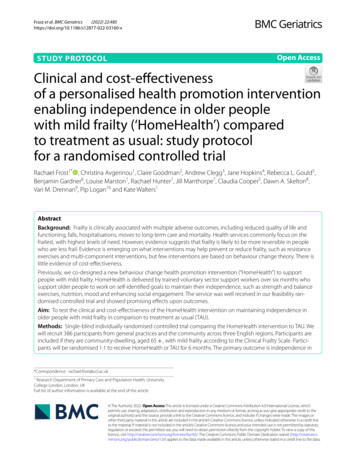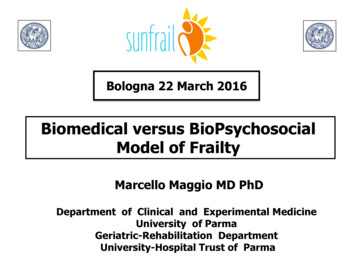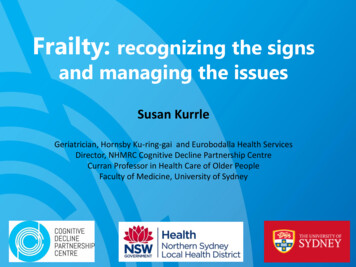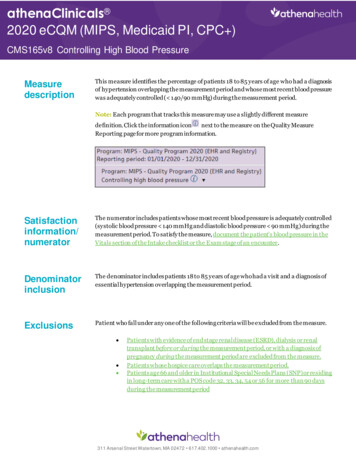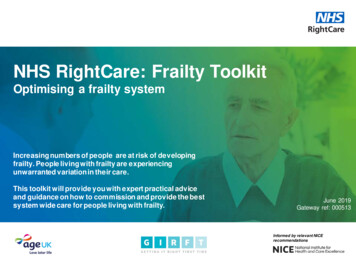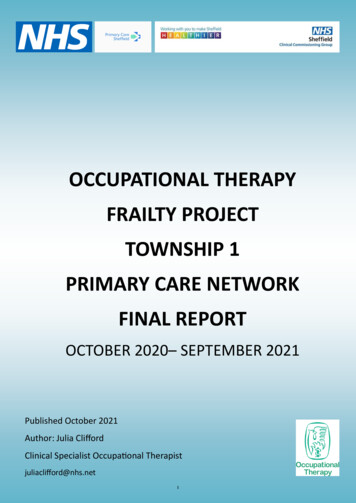
Transcription
OCCUPATIONAL THERAPYFRAILTY PROJECTTOWNSHIP 1PRIMARY CARE NETWORKFINAL REPORTOCTOBER 2020– SEPTEMBER 2021Published October 2021Author: Julia CliffordClinical Specialist Occupational Therapistjuliaclifford@nhs.net1
ACKNOWLEDGEMENTSThe frailty service was funded by Sheffield Clinical Commissioning Group.The Occupational Therapy Frailty service, and service evaluation was developed with input and supportfrom:Dr Tom Holdsworth (GP and Clinical Director Township 1 Primary Care Network)Nat Jones (Clinical Academic Occupational Therapist Sheffield Teaching Hospitals NHS Foundation Trust )Dr Laura Evans (Professional Head of Occupational Therapy, Sheffield Teaching Hospitals NHSFoundation Trust)Amanda Jones (Chief Allied Health Professional Sheffield Health and Social Care NHS Foundation Trust)Amber Wild (Professional Lead Occupational Therapist, Intermediate and Primary Care Services SheffieldHealth and Social Care NHS Foundation Trust)Carolyn Taylor (Research Coordinator for Combined Community and Acute Care Group SheffieldTeaching Hospitals NHS Foundation Trust)Jennifer Read (Research and Teaching Associate Sheffield School of Health and Related ResearchUniversity of Sheffield)Eileen Hall (Programme Manager for Personalisation South Yorkshire and Bassetlaw ICS, NHS SheffieldClinical Commissioning Group)The following clinical specialists and experts in frailty/older adults supported the initial and ongoingclinical role development:Gill Agar (Lead Clinical Specialist Physiotherapist Older Adult Rehabilitation Sheffield Teaching HospitalsNHS Foundation Trust)Laura Bidgood (Clinical Specialist Occupational Therapist NW1 Primary Care Network, Barking andDagenham)Charlotte Sutcliffe (Dementia Focused Occupational Therapist Adaptations, Housing and Health SheffieldCity Council)Laura Di Bona (Clinical Specialist Occupational Therapist SAPA 5 Primary Care Network Sheffield)Helen Blomfield (Trainee Advanced clinical practitioner, Township 2 Primary Care Network Sheffield)Thanks to the Township 1 Primary Care Network patients, carers and staff for providing feedback on theOccupational Therapy Frailty service2
EXECUTIVE SUMMARYBackground: On 1st October 2020 an Occupational Therapist (OT) funded by the SheffieldClinical Commissioning Group started working as part of a frailty service, with the six surgeries inTownship 1 Primary Care network. An Occupational Therapy service was set up offering apersonalised, holistic approach with patients aged over 65 living with moderate to severe frailtyin their own homes.Project aim: The overall project aim was to maximise patients’ independence, wellbeing, andtheir occupational performance levels, while reducing the pressure on GP appointments.Evaluation: An evaluation of the Occupational Therapy Frailty Service took place from 1stOctober 2020 to 30th September 2021. Descriptive and process data was collected describingthe patient demographic, referral source, goal attainment and Occupational TherapyIntervention. Patient feedback was gained and referrer surveys were also completed.Evaluation findings: 190 patients who were referred met the criteria for the OccupationalTherapy frailty service, and 136 patients received an ‘outreach phone review’ (calls made topatients identified as moderate/severely frail). The data identifies diverse Occupational Therapyinterventions, with supporting patients in the self-management of their activities of daily living,mobility and transfers, equipment and rail provision and establishing carer support strategiesbeing most prevalent. Clinical outcomes measured using the Goal attainment scale show a highlevel of clinical effectiveness with all patients reaching at least one of their identified goals.Subjective feedback from 25 patients suggests a high level of satisfaction with the service, withvalue placed on the accessibility of the service locally though a familiar route, the OccupationalTherapy approach in providing support and connection to other services, and the therapeuticimpact of Occupational therapy on patients’ self-managing their activities of daily living andoverall confidence levels.Referrers found the service generally accessible, valuing the speed and quality of the service intreating patients with complex presentations. GPs identified that the OT role can have a positiveimpact on their time, particularly with regard to the Occupational Therapist’s knowledge ofservices available to support patients and their carers. Additional role staff appreciated thesupport from the Occupational Therapist, and having direct access to refer to the service.Recommendations: The evaluation identifies the added value in continuing the OT frailty servicein the PCN. There is a need to further publicise and promote the service to ensure all GPs andpotential referrers are aware of what Occupational Therapy can offer patients living with frailty.Direct referrals from patients, reception and additional role staff are also identified as an area todevelop in order to limit GP contact and free up GP time. Expansion of the OccupationalTherapy role is indicated to potentially include patients under 65 living with long term conditionsor requiring support to return to work.3
CONTENTSPage NumberAcknowledgements2Executive Summary3Contents page41. Introduction52. Project Background53. Setting up the service:63.1 Project aims and objectives63.2 A new Occupational Therapy model for frailty in primary care63.3 Developing the infrastructure to support the role73.4 The Frailty service: an integrated approach74. Method for data collection85. Summary of direct referrals to the Occupational Therapy service96. Summary of patient demographic information107. Overview of Occupational Therapy interventions118. Therapeutic impact—Goal attainment129. Summary of non-referrals: patient outreach reviews1310. Patient and carer feedback14-1611. GP practice staff feedback17-2012. Conclusion2113. Recommendations2114. References224
1. INTRODUCTIONOn 30th January 2019, a successful Neighbourhood Transformation business case was made to theSheffield Clinical Commissioning Group (CCG) by Township 1 Primary Care Network (PCN) to provide aservice targeting care to frail older adults who are housebound. As part of the initial bid, a ClinicalSpecialist Occupational Therapist (OT) was funded on a 0.8 contract (4 days a week) for a one yearsecondment from 1st October 2020 to provide occupation focussed interventions to patients in thiscohort across 6 GP practices. This report provides information about the setting up of the OccupationalTherapy Frailty service, the types of interventions undertaken to improve patients’ occupationalperformance levels, descriptive details of the patients seen, clinical outcomes, feedback from those receiving the service and also from referrers into the service. This report considers learning from theproject evaluation, and recommendations for future clinical and service developments.2. PROJECT BACKGROUNDThe Occupational Therapy model proposed for working into Township 1 PCN supports the serviceredesign outlined in the NHS Long Term plan (2019) and the Update to the GP Contract Agreement(2020), where expanded PCN teams include a range of additional role health care professionals who arebest placed to meet patient need, and shift the balance of work away from GPs onto the relevant healthprofessional.This was the first Occupational Therapy role of its kind in Sheffield, with a growing number of OT’s inPrimary Care nationally having a specific focus working in frailty. Emerging evidence (McCabe and Greer2019, Brooks and Thew 2020) suggests that OTs are ideally placed to contribute to PCNs in providingpatient centred, holistic, occupation focussed interventions within participatory and anticipatory modelsof service delivery. Evidence further suggests that OTs have a unique, specialist role when working witholder adults experiencing frailty in Primary Care (Evans 2018). By focussing on the day to day occupationsthat matter to patients, offering a holistic approach to the physical, cognitive, emotional andenvironmental factors that impact on patients’ occupational roles, OTs add value to current serviceprovision in this context (Royal College of Occupational Therapists 2020)The OT Frailty service was set up during October and November 2020. The service was publicised usingposters and an initial newsletter distributed to surgeries; all practices were also visited to meet with staffand answer questions and promote the service. Due to COVID restrictions impacting on the secondedyear, it is recognised that the amount of face to face contact with practice staff was limited.The service evaluation outlined in this document aimed to identify the distinctive clinical and operationalimpact of the Occupational Therapy role in the Township 1 PCN Frailty Service has on patients and theircarers, GPs, and community partners. Specific objectives for the evaluation were: To capture descriptive data on referral rates, referral source and area of occupationalinterventionIdentify therapeutic impact on patient identified goalsCapture patients’, carers’ and GPs’ subjective experience of the OT roleEstablish the impact on GP time5
3. SETTING UP THE SERVICE3.1 PROJECT AIMS AND OBJECTIVESThe overall aim of the Occupational therapy Frailty service outlined by the initial bid to the Sheffield CCGwas to provide targeted Occupational Therapy to the frail older population in Township one primary carenetwork who are housebound. The Township 1 PCN covers six surgeries in: Birley; Hackenthorpe;Mosborough; Sothall; Owlthorpe and Crystal Peaks which are situated in the S12 and S20 geographicalpostcodes in the city.Specific service objectives were identified to : Support patients living with frailty in developing self management strategies to maximize theiroverall occupational performance, independence, quality of life and wellbeing in their own homes Test a person–centred, asset based model for OT practice for the frail older population in primarycare Incorporate a preventative, or ‘anticipatory’ OT role when working with older adults living withfrailty in Township 1 Primary care network3.2 A NEW OCCUPATIONAL TEHRAPY MODEL FOR FRAILTY IN PRIMARY CAREA model for Occupational Therapy working with frail older adults was set up (see diagram 1). The modelprovided three routes of contact into the service Direct referrals Staff working in GP practices directly referred to the OT via bookable appointmentsavailable on Systmone electronic patient record system. This aimed to use familiar existing systemsused by additional role first contact staff. Outreach reviews Patients were identified from Systmone frailty/housebound read codes andproactively contacted by phone for screening into the service. This part of the service specificallyaimed to identify patients who may not have accessed services/OT before and aimed to enhancethe preventative role in working with frail older adults. MDT Attendance The OT offered to attend the GP practice MDT meetings, and patients relevant tothe service were identified by the OT during the MDT discussionAll patients were contacted initially by phone, and where appropriate visited at home for a holistic, assetbased assessment using the personalised care approach, adhering to the comprehensive geriatricassessment (CGA) (British Geriatric Association 2019). Patients were offered OT interventions linked tothe assessment outcome and person-centred goals. The Goal Attainment Scale (GAS) (Rockwood et al2003) was used with patients to identify person centred, meaningful goals and achievement of the goal.Diagram 1. OCCUPATIONAL THERAPY FRAILTY SERVICE MODEL OF PRACTICEPATIENTSDirect referralsMDTAttendanceOutreachreviewsTOWNSHIP 1 PCN OT FRAILTY SERVICE MODELOTINTERVENTIONHolistic assessment of patients’ occupational performance/CGAPatient identified goal setting (GAS)Identification of self management strategiesReview and signposting to other services6
3.3 DEVELOPING THE INFRASTRUCURE TO SUPPORT THE OCCUPATIONAL THERAPY ROLEDuring the initial phase of the project, an infrastructure was developed to support the Occupational Therapyrole (see diagram 2). Operational and clinical expertise came from within the PCN, Sheffield Health and SocialCare Foundation Trust (SHSCFT), and Sheffield Teaching Hospitals Foundation Trust (STHFT). This supportdrew upon existing local and national networks . A monthly action learning set was established with twoOccupational Therapists working into other PCNs in the city (SAPA 5 and Township 2) as more OTs wererecruited. Specialist advice on Frailty and Service development was also accessed locally.Diagram 2 PRIMARY CARE OT SUPPORT NETWORKFormal supervisionSpecialist advisory inputT1 PCN Tom Holdsworth GPDr Laura Evans: Frailty/leadershipNat Jones: Evaluation/Service developmentOT Support andSHSCFT—Amber Wild, Amanda Jones Chief AHPSupervision NetworkOT support network—Local:OT Support Network—National:STHFT Community Clinical Specialists Meeting (once a month) facilitatedby Dr Laura EvansRCOT monthly drop in session for OTs working in GP practiceCommunity of Practice action learning set facilitated by Nat JonesFrailty OT peer supervision: Laura Bidgood/Amanda ShoreySocial media resources e.g. Twitter and Primary Care OT FB page3.4 THE FRAILTY SERVICE:AN INTEGRATED APPROACHDuring the initial setting up stage, services were contacted to scope out existing support available topatients with the aim of limiting duplication, promoting integrated working practice and creating a robustnetwork to ensure patients were linked in, and signposted to all available existing services to support theirhealth and wellbeing. (see diagram 3)Diagram 3 SERVICE NETWORK AND REFERRAL ROUTESActiverecoveryDistrictnursesMemoryClinicPCN Paramedic,additional rolesICTTIAPTCommunityDental CCCCsSocialPrescribersAgeUKMedequipDementiaAdvice ServiceAdultAccessTeamCWCAEquipment CentreCavendishCentre
WORKING ALONGSIDE ADDITIONAL ROLE STAFFLinks and working relations were established with the additional role staff in the PCN, illustrated in diagram4, with monthly meetings taking place. Additional role staff are increasingly referring directly into the Frailtyservice as the additional role staffing team develops.Diagram 4 OT WORKING LINKS DEVELOPED WITH ADDITIONAL ROLE STAFF Source of advice onmental health issuesand referral pathways Referrals received from paramedicwhen pt had fallen/not coping athomeSource of advice for OT when GPdoes not need to be contacted CPNPARAMEDICOT FRAILTYSERVICECARE COORDINATORSOCIALPRESCRIBERS Publicity, and co-ordinationof additional roles within theprimary care network Referrals received from socialprescribers when patients arestruggling with ADLs, requiringequipmentReferrals made by OT to connectpatients to community resources,benefits adviceSupport and advice from OT4. METHOD AND DATA COLLECTIONOnce the service was established, a service evaluation was planned using the following methods:Process measuresA spreadsheet was kept to document the number of referrals including: referral source, patient clinical frailtyscore, Patient identified goalsClinical outcome measure:The Goal Attainment Scale (Rockwood et al 2003) was used with patients to identify person centred,meaningful goals and achievement of the goalSubjective feedbackPatient and carer satisfaction: Patients and their carers discharged from the OT frailty service in June and July2021 were asked to complete a patient and carer satisfaction sheet. Patients and their carers were asked torate their satisfaction of the Frailty service using a Likert scale rating from 0 (very unsatisfied) to 5 (verysatisfied) Patients were asked to expand on their experience and give reasons for their scoring.GP /referrer satisfaction: an anonymous questionnaire distributed to referrers (GPs, Social prescribers,paramedic) using Google forms. The questionnaire included qualitative and quantitative data.TARGET POPULATIONThis service development project included patients who met the following criteria, as specified by theinitial bid to the CCG: Over 65 Housebound and cannot access their GP surgery Have a diagnosis of moderate/severe frailty Consented to Occupational Therapy involvement8
5. SUMMARY OF DIRECT REFERRALS TO OCCUPATIONAL THERAPY SERVICEA total of 219 direct referrals were received over the 12 month period; 190 referrals met the criteria toaccess the frailty service. Patients who were referred and did not meet the age referral criteria (n 12)were contacted by phone and signposted on to the appropriate services by the PCN OT in order toaddress patients’ work related support needs or long term condition management needs. It was noted byreferrers that OT availability locally in the PCN for under 65s would potentially add value to servicedelivery.10 patients were known to the Integrated Care Therapy Team (ICTT) and already receiving active therapy.The referral rates have grown steadily over the 12 months, with an average of 21 referrals received permonth since January 2021. Referrals were received from all six GP practices in Township 1 PCN; withmost referrals coming from Sothall and Mosborough GP practice.(n 214)71% of the referrals received into the frailty service were from GPs and physician’s Associates. Anincreasing number of referrals are being received from the additional role staff (9%) , including SocialPrescribers (SPs) and the Paramedic, and directly from reception staff (6%).As the service has become more established, patients are making direct contact with the OT to arrange areview and refer themselves for assessment, therefore avoiding the need to contact the GP/practicedirectly.9
6. SUMMARY OF PATIENT DEMOGRAPHIC INFORMATIONMost patients accessing the service were between the ages of 76 and 90, with more women (n 116) thanmen (n 74) being referred.With reference to ethnicity, patients were predominantly classified as White British (97%), beingreflective of the general population within the Primary Care Network.Patients’ levels of frailty were classified on initial assessment using the clinical frailty scale (BritishGeriatrics Society 2018) . Most patients presented as experiencing either moderate frailty (n 85) orsevere frailty (n 64), with smaller numbers of patients experiencing mild frailty (n 27), very severe frailty(n 11) or terminal illness (n 3)Clinical Frailty ScaleCFS5 Mildy Frail, more evident slowing, and need helpwith high order IADLsCFS6 Moderately frail, requiring help with all outsideactivities, can have problems with the stairs, and mayneed help with bathingCFS7 Severely frail, completely dependent on personalcareCFS8 Very severely frail, completely dependent,approaching end of lifeCFS9 Terminally ill, approaching end of life with lifeexpectancy of less than 6 months10
7. OVERVIEW OF OCCUPATIONAL THERAPY INTERVENTIONSPatients and their carers referred into the service were offered an assessment to identify self managementstrategies, and practical solutions to issues they face which impact on their overall occupationalperformance.Patient goalsPatients explored achieving or maintaining a breadth of occupational goals relating to the areas below.Patients frequently identified more than one goal to help improve the quality of their lives.Occupational Therapy interventions were wide-ranging, often working with alongside patients’ families. Themain areas for OT intervention throughout the 12 month period were to support patients in self managingactivities of daily living, mobility and transfers, equipment and rail provision and establishing carer supportstrategies.11
8. THERAPEUTIC IMPACT -GOAL ATTAINMENTA patient centred, as opposed to an impairment based goal outcome measure was chosen, which hasbeen validated to work with the frail older population (Rockwood et al 2003) . Using the Goal AttainmentScale, patients were asked to score if their goal has been achieved.Patients identified if the goal had been attained,which would be the ‘expected outcome’ (0) andwhether they had achieved more ( 1, 2), or less(-1,-2)than they had expected to achieve.All patients seen stated that they had achieved atleast one therapeutic goal, with 41% of patientidentified goals being met with their expectedoutcome.38% of goals were achieved with more than patientshad expected, and 21% being most favourable.It was noted that patients often identified thatequipment provision had more of an impact onoccupational performance than they had expected.Examples of patient goal attainmentMr S lives alone, and over recent years describes becomingincreasingly frail (CFS6—moderate frailty). He has a recentdiagnosis of dementia, which she and her family were strugglingto come to terms with.Mrs P lives with her son in law, following the recent loss of herdaughter.Goals: On initial assessment, Mrs P identified goals o access hershower and was requesting an adaptation/wet room. She alsowanted to be able to make meals and do the ironing butdescribed difficulties due to reduced standing tolerance whichprohibited her from participating in activities in the kitchen,relying on her son in law for meals etc. Mrs P further identified agoal to access the garden, which was difficult due to 3 stepsleading from her back door. Mrs P described feeling isolated andlow in mood following her family bereavement as was keen toaccess bereavement support.Goals: Mr S and her family identified goals to be safer at home;manage the stairs better following a ’trip’ on the stairs, feel moresupported and develop strategies to support Mr S’s memoryOT Intervention: An assessment at home was completed, andadvice provided on falls prevention, assistive technology e.g. Citywide care alarms, and a key safe. An assessment was made for asecond stair rail and rails to promote safe transfers in thebathroom. With consent, referrals were made to the DementiaAdvice Service and the Carer’s Centre. Compensatory memorystrategies were explored following a formal assessment (ACE111),for example using reminder systems for appointments andmedication.OT intervention: Mrs P was assessed at home, and with supportfrom OT, practised using a shower board and grab rail in her bathto shower. Mrs P trialled a perching stool to sit on when makingmeals/ironing; and was assessed for rails to provide access to thegarden. Mrs P was provided with support around her recent loss,and signposted to bereavement services.The OT visited twice at home, and phoned the patient/family 3times for monitoring/follow up.The OT visited three times at home, and phoned the patient threetimes for monitoring/follow upOutcome: Goals achieved. Mr S and his family scored their overallgoal attainment as 1, better than expectedOutcome: Goals achieved. Mrs P scored her overall goalattainment as 2, most favourable12
9. SUMMARY OF NON-REFERRALS: PATIENT OUTREACH REVIEWSFrom 1st October 2020 to September 30th 2021, outreach telephone reviews were completed with 136patients, identified by taking patient lists off Systmone electronic computer system who were coded as‘housebound’ and living with ‘moderate’ or ‘severe’ frailty. Patients were contacted by phone and offered aconversation which holistically explored areas such as how they were managing at home with activities ofdaily living, mobility and transfers; their mood and support network, access to social opportunities,nutritional levels, risks and any concerns patients could identify.37% of patients had active OT involvement following on from the initial conversation. Interventionscentred on: Signposting to other services, for example the social prescribers in order to access befriendingservices, benefits advice, and community activities Falls prevention, goals to improve mobility and transfers, equipment and rail provision and thedevelopment of self management strategies to support occupational performance.Patients who did not require active OT input frequently expressed being grateful for the review andopportunity to talk about how they are currently coping with day to day activities, and awareness of theservice should they require OT involvement in future. Patients frequently commented on the value of theconversation about what mattered to them in the context of the COVID pandemic when social isolation,and lack of interaction was prevalent for this cohort of patients.5 patients who were initially contacted through the outreach service have since self referred directlyinto the service.13
10. PATIENT AND CARER FEEDBACKAll patients discharged during June and July 2021 were asked to complete a brief patient and carersatisfaction questionnaire and provide feedback on their experience of the service. The questionnaireasked patients to rate their satisfaction level of the service that patient’s and their carers had received.They were asked to elaborate in the score with additional information describing the reasons for thescore and further information.PATIENT SATISFACTION RATING SCALEFeedback was received from 25Numberpatients accessing the service.OfOut of the 25 responses, 21 rated theirsatisfaction levels as ‘very satisfied’, and4 rated the level as ‘satisfied’.patientsPATIENT FEEDBACK—COMMENTS ON THE EXPERIENCE OF THE SERVICETaken together, the comments made by patients and their carers broadly fell into three overarching themes,where satisfaction related to the accessibility of the service, the overall approach of the occupational therapist,and the therapeutic impact of the service on their wellbeing, quality of life and independence levels.ACCESSIBILITYPatients were frequently grateful for how quickly they were seen by the OT, and also the speed at which actions were completed, particularly when accessing equipment required. This was noticeable with patients whohad not seen an OT before.‘We are delighted with the speed, and how quickly thewheelchair, the equipment came’ (patient’s wife)‘I’m pleased with the way my doctor referred to (theOT) and the speed of the service (patient)Significantly, patients and their carers highly valued accessing the Occupational Service through their GP astheir GP was a trusted referral source, being familiar to them and seeing the OT face to face at home.Patients appreciated that the Occupational Therapist was locally available, ‘joined up’ with the GP service andeasier to access. They identified how this connection helped to overcome potential barriers to accessing TheOccupational therapy service, such as travelling to services and anxiety, which can impact on access to serviceinvolvement.‘Because I’ve got mental health problems, knowing (the OT) came from the surgery really helps. Its nice to havethat ‘all in one’ thing rather than someone coming from somewhere else, that (the GP) recommended’ (patient)Its very good having someone I know on our doorstepwe can get help and advice from (patients partner)‘(The OT) put me at ease, its easier knowing shecame from the surgery ‘(Patient)14
Patients and carers appreciated having future OT input via their GP surgery, if required. They placed value on the continuity of the service in GP practice; and that the OT was now familiar to them.‘Its comforting to know the service is there’ (patient)‘I know (The OT) is there if I we need anything, if anythingchanges’ (patient’s daughter)APPROACHPatients identified the support and reassurance received from the OT as positively impacting on howthey coped with their overall occupational performance. This was particularly relevant given the impactof COVID restrictions on patients’ social networks and social isolation. Patients appreciated havingopportunity to talk openly about their current situation, personal stressors and functional difficulties.‘I’ve never had anyone ask if I need help, what’s hard for me - itsbrilliant. I’m finding everything a bit much, thanks for beingthere’ (Patient)‘You can talk to the OT, she listens. I didfind it useful, it really helped being reassured’ (patient)Patients further valued the OT’s general advice, problem solving and knowledge of other services thatpatients could connect with to provide support:‘I’m pleased with how the OT has been – Iknow if anything was possible, she would doit’ (patient)‘The OT knows the ‘ins and outs’ of what’s available, its beensmashing – very helpful and knowledgeable’ (patient)THERAPEUTIC IMPACTA key part of the feedback received highlighted how Occupational Therapy involvement impacted onpatients’ ability to function in their own homes and remain as independent as possible. This particularlyrelated to the role of equipment and self management strategies on patients achieving functional goals:‘I can get around my flat now, its much easier as thefurniture, my walker isn’t in the way. (patient)I’m so pleased someone has looked at my memory. I thinkits very useful to think about what can help (patient)‘Its much easier, I can get out of the bath (patient)Some patients recognised the impact that OT had on their confidence levels, as being instrumental inthe process of meeting their goals:‘its been a massive help, it gives me confidence that Iwon’t fall’ (patient)‘Its helped with my self-confidence, I’ve been outwith friends and I can use the trolley in the kitchen.The rails lovely’ . (patient)15
Finally, the OT role in prevention within this context was further highlighted in relation to preventing fallsby some patients and their carers:It’s a fantastic idea because it prevents falls before it happens, like with my father. Coming round, its less stressful andeverything happened quickly’ (patient’s daughter)Summary diagram 5 showing key satisfaction themes and points to emerge from patientand carer feedbackACCESSIBILITYAPPROACHTHERAPEUTICSpeed of actionSupportIMPACTFamiliar contextConnectionGoal achievementContinuityConfidencePreventionIn summary, overall s
Therapy frailty service, and 136 patients received an 'outreach phone review' (calls made to . that matter to patients, offering a holistic approach to the physical, cognitive, emotional and . The Goal Attainment Scale (GAS) (Rockwood et al 2003) was used with patients to identify person centred, meaningful goals and achievement of the .
